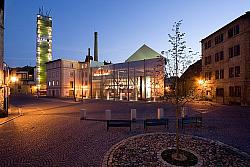Louny – Kadaň
Route length: 64 km
Description of the route:
- Louny - Žatec - Krásný Dvůr - Mount Uhošť - Pokutice - Kadaň
Louny
A possibility to have a swim in the indoor swimming pool, or there are the outdoor swimming pool grounds in the south-western edge of the town. The town walls and reconstructed bastions, the Žatec Gate, the neo-Renaissance town hall built between 1886 and 1887 and also the Gothic House of Sokols of Mory, today a museum, are the main attractions of the town.
Žatec
Parking is available directly in the centre of the town, at the square. The town of Žatec has a rich history (the first written reference dates back to 1004) and a plenty of well-preserved monuments. The historical centre has been preserved as an urban conservation area since 1961, still preserving parts of the fortification walls with towers (the Kněžská brána /Priestly Gate/, the Libočanská brána /Libočany Gate/, the Husitská bašta /Hussite Bastion/). The two-tower Temple of the Assumption of the Virgin Mary, the Capuchin monastery with the early Baroque Church of Coronation of Virgin Mary, the late Gothic Hošťálek´s house No. 48 at the square náměstí Svobody are definitely worth seeing. Žatec is an important hop-growing centre, with a 700-year-long tradition, and therefore it organizes an annual traditional festival Dočesná at the beginning of September to celebrate the end of the hop harvest.
Krásný Dvůr
The Baroque chateau, accessible to public, is worth visiting. The original fortress was rebuilt into a representative mansion for F J Czernin. A large English park with an area of 96 hectares and five ponds was created in the surroundings. There are meadows with centuries-old oak trees, the oldest of which is about 1000 years old. The park is scattered with romantic buildings such as the Chinese Pavilion, Pan´s Temple and more. There is a paid car park in front of the chateau.
Hora Uhošť /MountUhošť/
This distinctive mountain is worth a tour. Initially, we have to climb 1 km up to the peak plateau and then walk around this mount along its edge, which is worth being cautious because the cliff on the edge of the mount is very steep and falls to a depth of many tens of meters. Úhošť is not only a significant landscape dominant, but it is important for natural sciences (the highest degree of protection given to a national nature preserve) and for history (a settlement from the Bronze Age is located on the top). After visiting the top part, the educational trail and the red tourist mark will take us down, under the rocky precipices and further on to a small road leading from the village of Zásada to the village of Pokutice.
Pokutice
The village near Kadaň where the educational trail starts and ends.
Kadaň
At the Mírové náměstí /the main square/ you can see the Gothic town hall tower, which is 53.7 m high. Undoubtedly, another important monument is the parishChurch of Promotion of the Holy Cross, originally built in the Gothic style and later on rebuilt in the Baroque style in the 18th century after several fires. Right in the middle of the Mírové náměstí is erected a plague column called the Holy Trinity Column. Dating back to the 14th century, the Katova ulička /Executioner's Lane/, which previously served as a waste sewer and still are part of the fortification walls today, leads from the square. At the end of the Katova ulička is the executioner´s house, earlier occupied by an executioner who stayed in the town from time to time. The Žatec Barbican is a remnant of the Žatec Gate, also known as the Prague Gate, which has been knocked down. Therefore, only the space in front of the gate, which faces the east, has remained. The only gate preserved in the town is the Mikulovická Gate, also called the Holy Gate, which remembers arrivals of many important historical figures, such as Charles IV, Wenceslas II, Maria Theresia and Joseph II. KadaňCastle, commissioned by Přemysl Otakar II, was built in the second half of the 13th century to the south, above the River Ohře. The castle has a square floor plan and was later rebuilt by Maria Theresia into barracks in the 18th century, thereby losing its medieval character.






